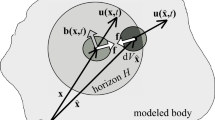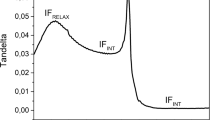Abstract
Behavior of NiTi shape memory alloys under complex loading is still a subject of both experimental and theoretical investigations. One of the simplest geometries, in which the material is loaded in combined mode and which has also several practical applications, is a simple helical spring. In this contribution, mechanical response of NiTi superelastic spring is analyzed in detail by numerical simulation and the results are compared to experiments. The simulations show complex stress state, which develops during spring stretching. Analyzing fatigue tests with respect to simulated behavior allowed us to find relation between fatigue resistance and periodic changes in volume fraction of martensite induced by cyclic mechanical loading. The work also underlines an extension of the range of stroke amplitudes guaranteeing enhanced life performance of the spring when material transforms through the R-phase.







Similar content being viewed by others
Notes
Let us note that there is a direct relation between dissipation function and corresponding yield function through Legendre transformation if some mathematical assumptions are satisfied.
Anisotropy of elastic properties was experimentally confirmed in Ref 23. However, because of difficulties with complete determination of stiffness tensor (5 independent constants for transverse isotropic material), assumption of elastic isotropy was adopted (similarly to Ref 5-10) and elastic properties were determined only by two constants—Young modulus E and shear modulus G. This simplification can only slightly influence the simulation as only shear and tensile/compressive stress components are significant in loaded spring.
References
D.J. Hartl, D.C. Lagoudas, F.T. Calkins, and J.H. Mabe, Use of a Ni60Ti Shape Memory Alloy for Active Jet Engine Chevron Application: I. Thermomechanical Characterization, Smart Mater. Struct., 2009, 19, p 015020
L.G. Machado and M.A. Savi, Medical Applications of Shape Memory Alloys, Braz. J. Med. Biol. Res., 2003, 36, p 683–691
D. Vokoun, D. Majtás, M. Frost, P. Sedlák, and P. Šittner, Shape Memory Hooks Employed in Fasteners, J. Mater. Eng. Perform., 2009, 18, p 706–710
P. Sittner, L. Heller, J. Pilch et al., Roundrobin SMA Modeling, ESOMAT 2009: The 8th European Symposium on Martensitic Transformations, EDP Sciences, P. Sittner, L. Heller, and V. Paidar, Eds., 2009, p 08001
J. Arghavani, F. Auricchio, R. Naghdabadi, A. Reali, and S. Sohrabpour, A 3-D Phenomenological Constitutive Model for Shape Memory Alloys Under Multiaxial Loadings, Int. J. Plast., 2010, 26, p 976–991
Y. Chemisky, A. Duval, E. Patoor, and T. Ben Zineb, Constitutive Model for Shape Memory Alloys Including Phase Transformation, Martensitic Reorientation and Twins Accommodation, Mech. Mater., 2011, 43, p 361–376
D.C. Lagoudas, D.J. Hartl, Y. Chemisky, L.G. Machado, and P. Popov, Constitutive Model for the Numerical Analysis of Phase Transformation in Polycrystalline Shape Memory Alloys, Int. J. Plast., 2012, 32–33, p 155–183
M. Panico and L.C. Brinson, A Three-Dimensional Phenomenological Model for Martensite Reorientation in Shape Memory Alloys, J. Mech. Phys. Solids, 2007, 55, p 2491–2511
Z. Moumni, W. Zaki, and Q.S. Nguyen, Theoretical and Numerical Modeling of Solid-Solid Phase Change: Application to the Description of the Thermomechanical Behavior of Shape Memory Alloys, Int. J. Plast., 2008, 24, p 614–645
A.F. Saleeb, S.A. Padula, and A.A. Kumar, A Multi-Axial, Multimechanism Based Constitutive Model for the Comprehensive Representation of the Evolutionary Response of SMAs Under General Thermomechanical Loading Conditions, Int. J. Plast., 2011, 27, p 655–687
L. Saint-Sulpice, S. Arbab Chirani, and S. Calloch, A 3D Super-Elastic Model for Shape Memory Alloys Taking into Account Progressive Strain Under Cyclic Loadings, Mech. Mater., 2009, 41, p 12–26
P. Sedlak, M. Frost, B. Benesova, P. Sittner, and T. Ben Zineb, Thermomechanical Model for NiTi-Based Shape Memory Alloys Including R-phase and Material Anisotropy Under Multi-Axial Loadings, Int. J. Plast., 2012, 39, p 132–151
C. Liang, A Rogers Design of Shape Memory Alloy Actuators, J. Intell. Mater. Syst. Struct., 1997, 8, p 303–313
Y. Toi, J.-B. Lee, and M. Taya, Finite Element Analysis of Superelastic, Large Deformation Behavior of Shape Memory Alloy Helical Springs, Comput. Struct., 2004, 82, p 1685–1693
R. Mirzaeifar, R. DesRoches, and A. Yavari, A Combined Analytical, Numerical, and Experimental Study of Shape-Memory-Alloy Helical Springs, Int. J. Solids Struct., 2011, 48, p 611–624
A.F. Saleeb, B. Dhakal, M.S. Hosseini, and S.A. Padula, Large Scale Simulation of NiTi Helical Spring Actuators Under Repeated Thermomechanical Cycles, Smart Mater. Struct., 2013, 22, p 094006
K. Hirmanova, J. Pilch, J. Racek, L. Heller, P. Sittner, L. Recman, M. Petrenec, and P. Sedlak, Physical Simulation of the Random Failure of Implanted Braided NiTi Stents, J. Mater. Eng. Perform, accepted in
A. Sadjadpour and K. Bhattacharya, A Micromechanics-Inspired Constitutive Model for Shape-Memory Alloys: the One-Dimensional Case, Smart Mater. Struct., 2007, 16, p S51–S62
C. Grabe and O.T. Bruhns, On the Viscous and Strain Rate Dependent Behavior of Polycrystalline NiTi, Int. J. Solids Struct., 2008, 45, p 1876–1895
Q.S. Nguyen, Stability and Nonlinear Solid Mechanics, John Wiley, New York, 2000, p 17–40
K. Hackl and F.D. Fischer, On the Relation Between the Principle of Maximum Dissipation and Inelastic Evolution Given by Dissipation Potentials, Proc. R. Soc. A, 2008, 464, p 117–132
M. Frost, B. Benesova, and P. Sedlak, A Microscopically Motivated Constitutive Model for Shape Memory Alloys: Formulation, Analysis and Computations, Math. Mech. Solids, accepted in
S. Qiu, B. Clausen, S.A. Padula, R.D. Noebe, and R. Vaidyanathan, On Elastic Moduli and Elastic Anisotropy in Polycrystalline Martensitic NiTi, Acta Mater., 2011, 59, p 5055–5066
P. Sittner, M. Landa, P. Lukas, and V. Novak, R-phase Transformation Phenomena in Thermomechanically Loaded NiTi Polycrystals, Mech. Mater., 2006, 38, p 475–492
K. Gall, H. Sehitoglu, Y.I. Chumlyakov, and I.V. Kireeva, Tension-Compression Asymmetry of the Stress-Strain Response in Aged Single Crystal and Polycrystalline NiTi, Acta Mater., 1999, 43, p 1203–1217
V. Grolleau, H. Louche, V. Delobelle, A. Penin, G. Rio, Y. Liu, and D. Favier, Assessment of Tension-Compression Asymmetry of NiTi Using Circular Bulge Testing of Thin Plates, Scr. Mater., 2011, 65, p 347–350
S.C. Mao, J.F. Luo, Z. Zhang, M.H. Wub, Y. Liu, and X.D. Han, EBSD Studies of the Stress-Induced B2-B19’ Martensitic Transformation in NiTi Tubes Under Uniaxial Tension and Compression, Acta Mater., 2010, 58, p 3357–3366
Y.C. Shu and K. Bhattacharya, The Influence of Texture on the Shape-Memory Effect in Polycrystals, Acta Mater., 1998, 46, p 5457–5473
B. Reedlunn, C.B. Churchill, E.E. Nelson, J.A. Shaw, and S.H. Daly, Tension, Compression, and Bending of Superelastic Shape Memory Alloy Tubes, J. Mech. Phys. Solids, 2014, 63, p 506–537
S. Miyazaki and K. Otsuka, Deformation and Transition Behavior Associated with the R-phase in Ti-Ni Alloys, Metall. Trans. A, 1986, 17A, p 53–63
T. Atanacković and M. Achenbach, Moment-Curvature Relations for a Pseudoelastic Beam, Contin. Mech. Thermodyn., 1989, 1(1), p 73–80
Ella-CS s.r.o., http://www.ellacs.eu/stents.html
R. Mirzaeifar, R. DesRoches, A. Yavari, and K. Gall, Coupled Thermo-Mechanical Analysis of Shape Memory Alloy Circular Bars in Pure Torsion, Int. J. Non-Linear Mech., 2012, 47, p 118–128
M. Frost, P. Sedlak, A. Kruisova, and M. Landa, Simulations of Self-Expanding Braided Stent Using Macroscopic Model of NiTi Shape Memory Alloys Covering R-Phase, J. Mater. Eng. Perform., submitted to
Acknowledgments
We would like to thank to prof. T. Ben Zineb for providing access to CLCM computation cluster (Centre Lorrain de calcul haute performance en mécanique, France). This work has been conducted within the institutional project RVO: 61388998 of IT ASCR, v.v.i., and within the CENTEM project CZ.1.05/2.1.00/03.0088. The research has also been supported by the Grant Agency of the Czech Republic through grant projects Nos. 13-13616S, 14-28306P, and 14-15264S and by Academy of Sciences through internal project No. M100761203.
Author information
Authors and Affiliations
Corresponding author
Rights and permissions
About this article
Cite this article
Sedlák, P., Frost, M., Kruisová, A. et al. Simulations of Mechanical Response of Superelastic NiTi Helical Spring and its Relation to Fatigue Resistance. J. of Materi Eng and Perform 23, 2591–2598 (2014). https://doi.org/10.1007/s11665-014-0906-y
Received:
Revised:
Published:
Issue Date:
DOI: https://doi.org/10.1007/s11665-014-0906-y




